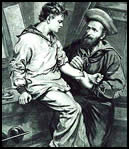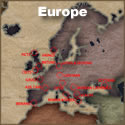Tattoos in Early France & ItalyJean Baptiste Cabri, was a French sailor
discovered by Georg H. von Langsdorff, the naturalist on Krusenstern's Russian
expedition, living in the Marquesas in 1804. There were two Europeans on the island,
an Englishman named Roberts and a
Frenchman, a native of Bourdeaux, named
Jean Baptiste Cabri. These two Europeans
lived in a state of great enmity. Cabri was
tattooed, and had married the daughter of
one of the inferior chiefs. He appears to
have been an unprincipled fellow, and did
not possess such influence over the natives
as the Englishman. He was however
brought away by the Russians, and being
an excellent swimmer, was afterwards
engaged as teacher of that useful art to the
corps of marine cadets at Cronstadt, France.
 Afterwards, Cabri displayed himself at fairs,
becoming the first European to exhibit as a
tattooed man.
Afterwards, Cabri displayed himself at fairs,
becoming the first European to exhibit as a
tattooed man.
In France, tattooing was popular among seamen, laborers and convicts during
the first part of the 19th century. Members of the middle and upper classes,
thought tattooing was beneath their dignity and it was never popular amongst the
wealthy as it was in England. The Catholic Church had traditionally opposed
tattooing on the grounds it was associated with superstition and paganism.
The medical profession opposed tattooing because of the complications it
could cause. In 1837, a leading doctor wrote about a young woman who died as a
result of an infection related to a tattoo. In 1853, a physician, M. Hutin
reported the first case in which syphilis was transmitted by tattooing. He
wrote: "A soldier allowed himself to be tattooed by a man who was suffering from
syphilis and who had chancres on his lips. The soldier was a virgin and
perfectly healthy, and the tattooer only punctured his arm a few times. The
Chinese ink used by the tattooer had dried up in a shell and several times the
tattooer moistened his needles by spitting on them and diluted the ink with his
saliva. In this way he inoculated the soldier with syphilis."
Knowledge of how infections spread weren't yet known and tattoo artists
routinely used the same needles on more than one customer without cleaning them.
They mixed their ink in clamshells and diluted it with saliva. It was normal to
clean off a fresh tattoo with saliva, tobacco juice or urine.
French craftsmen often bore the insignia of their profession tattooed on
their biceps like the fireman, coolies and litter-bearers of Japan. These
craftsmen, or journeymen, would travel from town to town to ply their trade. In
the absence of a diploma, which could, in any case, be lost or forged, they bore
proof of their qualification on their skin. Furthermore, this method of
identification enabled them to find work throughout Europe, regardless of their
ability to speak the language of the country they were in. In the Dechambre
dictionary, Professor Lacassagne provides a list of the insignia of these
craftsmen. For example:
Stone Carvers - Compasses, a right angle, a chisel and a plumb line
Carpenters - Display a plane and pliers
Butchers - Have a bull's head on crossed knives
Bakers - Scales, kneading trough and a loaf
Barbers - Comb and crossed scissors
Cobblers - An awl and a boot
Blacksmiths - An anvil and hammer
Sailors - An anchor
Vine-Growers - A bunch of grapes
Gunsmiths - A pistol
In 1791, a revolutionary law (the Le Chapelier law) resulting from the Aliard
Decree; abolished these guilds of craftsmen. Gradually the journeyman's emblems
were forgotten. Only a few passionate craftsmen refused to let them go. It is
still possible to find craftsmen who remain loyal to this tradition and bear a
tattoo which indicates their journeyman status.
Tattooing was never completely outlawed in France, but the fact it was
forbidden in the Army and Navy put most professionals out of business, and there
are few records of tattooing outside of prisons in Frances during the late 19th
century.
The first written account of tattooing amongst convicts appeared in Cesare
Lombroso's L"Uomo Deliquent in 1876. He was a professor of psychiatry and
criminal anthropology at the University of Turin in Italy. He examined 5,343
criminals and found that about 10% of the adults were tattooed. He recommended
that when examining a criminal, prison officials should make a detailed record
of their tattoos. He made the first statistical records of tattooing and a
record of tattoo designs of Italian convicts.
Numerous references to tattooing can be found in 18th and 19th century French
literature. In the 1784 play, Le Mariage de Figaro, the infant Figaro is
tattooed by his doctor for identification purposes. In Les Miserables,
ex-convict Jean Valjean proves his identity in court by accurately describing
tattoos on two convicts whom he had known many before in prison.
Tattoos were often used in French court cases to establish the identity of
the accused, and for reason French prisons regulations dating from 1808 required
prison officials to make detailed records of tattoos of each convict.
In 1880, Dr. Alexander Lacassagne, a professor of medical jurisprudence in
Lyons observed many tattoos amongst the soldiers of the African Battalions.
These battalions were made up of men who had served prison terms for offenses
such as murder, desertion and theft. Lacassagne developed a way to trace tattoos
on a piece of transparent paper that he placed over the tattoo. In this way he
collected over 2,000 tattoo designs, many of which he reproduced in a work
titled, Les tatouages, etude anthropologique et medico-legale (Paris, 1881).
Lacassagne classified his tattoo designs according to subject matter and the
position on the body. Many of the designs are still favourites today and include
arrows, names, initials and dates;. But in other ways, French tattooing was
unique. Many convicts had had mottoes in large letters tattooed across their
chests or backs and included: "Death to Unfaithful Women"; "Kill the Pigs",
"Death to the French Officers;" "Vengeance;" "Liberty or Death;" "Child of
Misfortune;" Born under an Unlucky Star;" "The Past has cheated, the present
torments me, the future terrifies me;" "The Whole of France is not
worth a pile of Shit."
Ambitious, full-scale back pieces portrayed scenes from history, mythology
and literature. Lacassagne counted over thirty tattoos featuring the Three
Musketeers and also popular were portraits of Napoleon, Joan of Arc, Charlotte
Corday, Garibaldi, Bismarck and other historical figures. The most popular
mythological figures were Bacchus, Venus and Apollo.
The most popular erotic designs were the female bust and the nude female. The
most unusual were a uniform a general that covered the whole body.
He found words tattooed below the navel: "Come ladies, to the fountain of
love;" "Pleasure for girls"; "She thinks of me" on the buttocks.
His book is a valuable source for those interested in the history of
tattooing with all kinds of art.
Tattoo Museum Bibliography, Resources and Links
 See all European Tattoo Culture Articles here
See all European Tattoo Culture Articles here
NEXT >>
Germany
